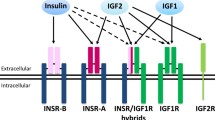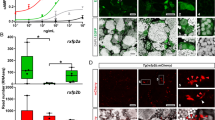Abstract
Insulin-like factor 3 (INSL3) is expressed in Leydig cells of the testis and theca cells of the ovary. This peptide affects testicular descent by acting on gubernaculum via its specific receptor leucine-rich repeat-containing G proteincoupled receptor 8 (LGR8). From initial animal data showing the cryptorchid phenotype of Insl3/ Lgr8 mutants, an extensive search for mutations in INSL3 and LGR8 genes was undertaken in human patients with cryptorchidism, and a frequency of mutation of 4–5% has been detected. However, definitive proofs of a causative role for some of these mutations are still lacking. More recent data suggest additional paracrine (in the testis and ovary) and endocrine actions of INSL3 in adults. INSL3 circulates at high concentrations in serum of adult males and its production is dependent on the differentiation effect of LH. Therefore, INSL3 is increasingly used as a specific marker of Leydig cell differentiation and function.
Similar content being viewed by others
References
Adham IM, Burkhardt E, Benahmed M, Engel W. Cloning of a cDNA for a novel insulin-like peptide of the testicular Leydig cells. J Biol Chem 1993, 268: 26668–72.
Burkhardt E, Adham IM, Hobohm U, Murphy D, Sander C, Engel W. A human cDNA coding for the Leydig insulin-like peptide (Ley I-L). Hum Genet 1994, 94: 91–4.
Ivell R, Balvers M, Domagalski R, Ungefroren H, Hunt N, Schulze W. Relaxin-like factor: a highly specific and constitutive new marker for Leydig cells in the human testis. Mol Hum Reprod 1997, 3: 459–66.
Tashima LS, Hieber AD, Greenwood FC, Bryant-Greenwood GD. The human Leydig insulinlike (hLEY I-L) gene is expressed in the corpus luteum and trophoblast. J Clin Endocrinol Metab 1995, 80: 707–10.
Nef S, Parada LF. Cryptorchidism in mice mutant for Insl3. Nat Genet 1999, 22: 295–9.
Zimmermann S, Steding G, Emmen JM, et al. Targeted disruption of the Insl3 gene causes bilateral cryptorchidism. Mol Endocrinol 1999, 13: 681–91.
Overbeek PA, Gorlov IP, Sutherland RW, et al. A transgenic insertion causing cryptorchidism in mice. Genesis 2001, 30: 26–35.
Hsu SY, Nakabayashi K, Nishi S, et al. Activation of orphan receptors by the hormone relaxin. Science 2002, 295: 671–4.
Kumagai J, Hsu SY, Matsumi H, et al. INSL3/Leydig insulinlike peptide activates the LGR8 receptor important in testis descent. J Biol Chem 2002, 277: 31283–6.
Bogatcheva NV, Truong A, Feng S, Engel W, Adham IM, Agoulnik AI. GREAT/LGR8 is the only receptor for insulinlike 3 peptide. Mol Endocrinol 2003, 17: 2639–46.
Balvers M, Spiess AN, Domagalski R, et al. Relaxin-like factor expression as a marker of differentiation in the mouse testis and ovary. Endocrinology 1998, 139: 2960–70.
Kawamura K, Kumagai J, Sudo S, et al. Paracrine regulation of mammalian oocyte maturation and male germ cell survival. Proc Natl Acad Sci USA 2004, 101: 7323–8.
Hombach-Klonisch S, Schon J, Kehlen A, Blottner S, Klonisch T. Seasonal expression of INSL3 and Lgr8/Insl3 receptor transcripts indicates variable differentiation of Leydig cells in the roe deer testis. Biol Reprod 2004, 71: 1079–87.
Foresta C, Bettella A, Vinanzi C, et al. INSL3: a novel circulating hormone of testis origin in humans. J Clin Endocrinol Metab 2004, 89: 5952–8.
Foresta C, Ferlin A. Role of INSL3 and LGR8 in cryptorchidism and testicular functions. Reprod Biomed Online 2004, 9: 294–8.
Ferlin A, Foresta, C. Insulin-like factor 3: a novel circulating hormone of testicular origin in humans. Ann NY Acad Sci 2005, 1041: 497–505.
Bay K, Hartung S, Ivell R, et al. Insulin-like factor 3 serum levels in 135 normal men and 85 men with testicular disorders: relationship to the luteinizing hormone-testosterone axis. J Clin Endocrinol Metab 2005, 90: 3410–8.
Adham IM, Emmen JM, Engel W. The role of the testicular factor INSL3 in establishing the gonadal position. Mol Cell Endocrinol 2000, 160: 11–6.
O’Shaughnessy PJ, Willerton L, Baker PJ. Changes in Leydig cell gene expression during development in the mouse. Biol Reprod 2002, 66: 966–75.
Boockfor FR, Fullbright G, Bullesbach EE, Schwabe C. Relaxin-like factor (RLF) serum concentrations and gubernaculum RLF receptor display in relation to pre- and neonatal development of rats. Reproduction 2001, 122: 899–906.
McKinnell C, Sharpe RM, Mahood K, et al. Expression of insulin-like factor 3 (Insl3) protein in the rat testis during fetal and postnatal development and in relation to cryptorchidism induced by in utero exposure to Di (n-butyl) phthalate. Endocrinology Jul 21, 2005 [Epub ahead of print].
Gorlov IP, Kamat A, Bogatcheva NV, et al. Mutations of the GREAT gene cause cryptorchidism. Hum Mol Genet 2002, 11: 2309–18.
Kubota Y, Nef S, Farmer PJ, Temelcos C, Parada LF, Hutson JM. Leydig insulin-like hormone, gubernacular development and testicular descent. J Urol 2001, 165: 1673–5.
Adham IM, Steding G, Thamm T, et al. The overexpression of the insl3 in female mice causes descent of the ovaries. Mol Endocrinol 2002, 16: 244–52.
Emmen JM, McLuskey A, Adham IM, Engel W, Grootegoed JA, Brinkmann AO. Hormonal control of gubernaculum development during testis descent: gubernaculum outgrowth in vitro requires both insulin-like factor and androgen. Endocrinology 2000,141: 4720–7.
Emmen JM, McLuskey A, Adham IM, et al. Involvement of insulin-like factor 3 (Insl3) in diethylstilbestrol-induced cryptorchidism. Endocrinology 2000, 141: 846–9.
Smith KJ, Wade JD, Claasz AA, et al. Chemical synthesis and biological activity of rat INSL3. J Pept Sci 2001, 7: 495–501.
Kubota Y, Temelcos C, Bathgate RA, et al. The role of insulin 3, testosterone, Mullerian inhibiting substance and relaxin in rat gubernacular growth. Mol Hum Reprod 2002, 8: 900–5.
Hsu S Y, Nakabayashi K, Nishi S, et al. Relaxin signaling in reproductive tissues. Mol Cell Endocrinol 2003, 202: 165–7.
Nef S, Shipman T, Parada LF. A molecular basis for estrogeninduced cryptorchidism. Dev Biol 2000, 224: 354–61.
Koskimies P, Levallet J, Sipila P, Huhtaniemi I, Poutanen M. Murine relaxin-like factor promoter: functional characterization and regulation by transcription factors steroidogenic factor 1 and DAX-1. Endocrinology 2002, 143: 909–19.
Shen JH, Ingraham HA. Regulation of the orphan nuclear receptor steroidogenic factor 1 by Sox proteins. Mol Endocrinol 2002, 16: 529–40.
Koskimies P, Virtanen H, Lindstrom M, et al. A common polymorphism in the human relaxin-like factor (RLF) gene: no relationship with cryptorchidism. Pediatr Res 2000, 47: 538–41.
Krausz C, Quintana-Murci L, Fellous M, Siffroi JP, McElreavey K. Absence of mutations involving the INSL3 gene in human idiopathic cryptorchidism. Mol Hum Reprod 2000, 6: 298–302.
Tomboc M, Lee PA, Mitwally MF, Schneck FX, Bellinger M, Witchel SF. Insulin-like 3/relaxin-like factor gene mutations are associated with cryptorchidism. J Clin Endocrinol Metab 2000, 85: 4013–8.
Lim HN, Raipert-de Meyts E, Skakkebaek NE, Hawkins JR, Hughes IA. Genetic analysis of the INSL3 gene in patients with maldescent of the testis. Eur J Endocrinol 2001, 144: 129–37.
Marin P, Ferlin A, Moro E, Garolla A, Foresta C. Different insulin-like 3 (INSL3) gene mutations not associated with human cryptorchidism. J Endocrinol Invest 2001, 24: RC13–5.
Marin P, Ferlin A, Moro E, et al. Novel insulin-like 3 (INSL3) gene mutation associated with human cryptorchidism. Am J Med Genet 2001, 103: 348–9.
Takahashi I, Takahashi T, Komatsu M, Matsuda J, Takada G. Ala/Thr60 variant of the Leydig insulin-like hormone is not associated with cryptorchidism in the Japanese population. Pediatr Int 2001, 43: 256–8.
Baker LA, Nef S, Nguyen MT, et al. The insulin-3 gene: lack of a genetic basis for human cryptorchidism. J Urol 2002, 167: 2534–7.
Canto P, Escudero I, Soderlund D, et al. A novel mutation of the insulin-like 3 gene in patients with cryptorchidism. J Hum Genet 2003, 48: 86–90.
Ferlin A, Simonato M, Bartoloni L, et al. The INSL3-LGR8/ GREAT ligand-receptor pair in human cryptorchidism. J Clin Endocrinol Metab 2003, 88: 4273–9.
Feng S, Cortessis VK, Hwang A, et al. Mutation analysis of INSL3 and GREAT/LGR8 genes in familial cryptorchidism. Urology 2004, 64: 1032–6.
Roh J, Virtanen H, Kumagai J, et al. Lack of LGR8 gene mutation in Finnish patients with a family history of cryptorchidism. Reprod Biomed Online 2003, 7: 400–6.
Foresta C, Ferlin A, Garolla A, Milani C, Oliva G, Rossato M. Functional and cytologic features of the contralateral testis in cryptorchidism. Fertil Steril 1996, 66: 624–9.
Nguyen MT, Showalter PR, Timmons CF, Nef S, Parada LF, Baker LA. Effects of orchiopexy on congenitally cryptorchid insulin-3 knockout mice. J Urol 2002, 168: 1779–83.
Foster PM. Disruption of reproductive development in male rat offspring following in utero exposure to phthalate esters. Int J Androl 2006, 29: 140–7.
Author information
Authors and Affiliations
Corresponding author
Rights and permissions
About this article
Cite this article
Ferlin, A., Arredi, B., Zuccarello, D. et al. Paracrine and endocrine roles of insulin-like factor 3. J Endocrinol Invest 29, 657–664 (2006). https://doi.org/10.1007/BF03344168
Accepted:
Published:
Issue Date:
DOI: https://doi.org/10.1007/BF03344168




